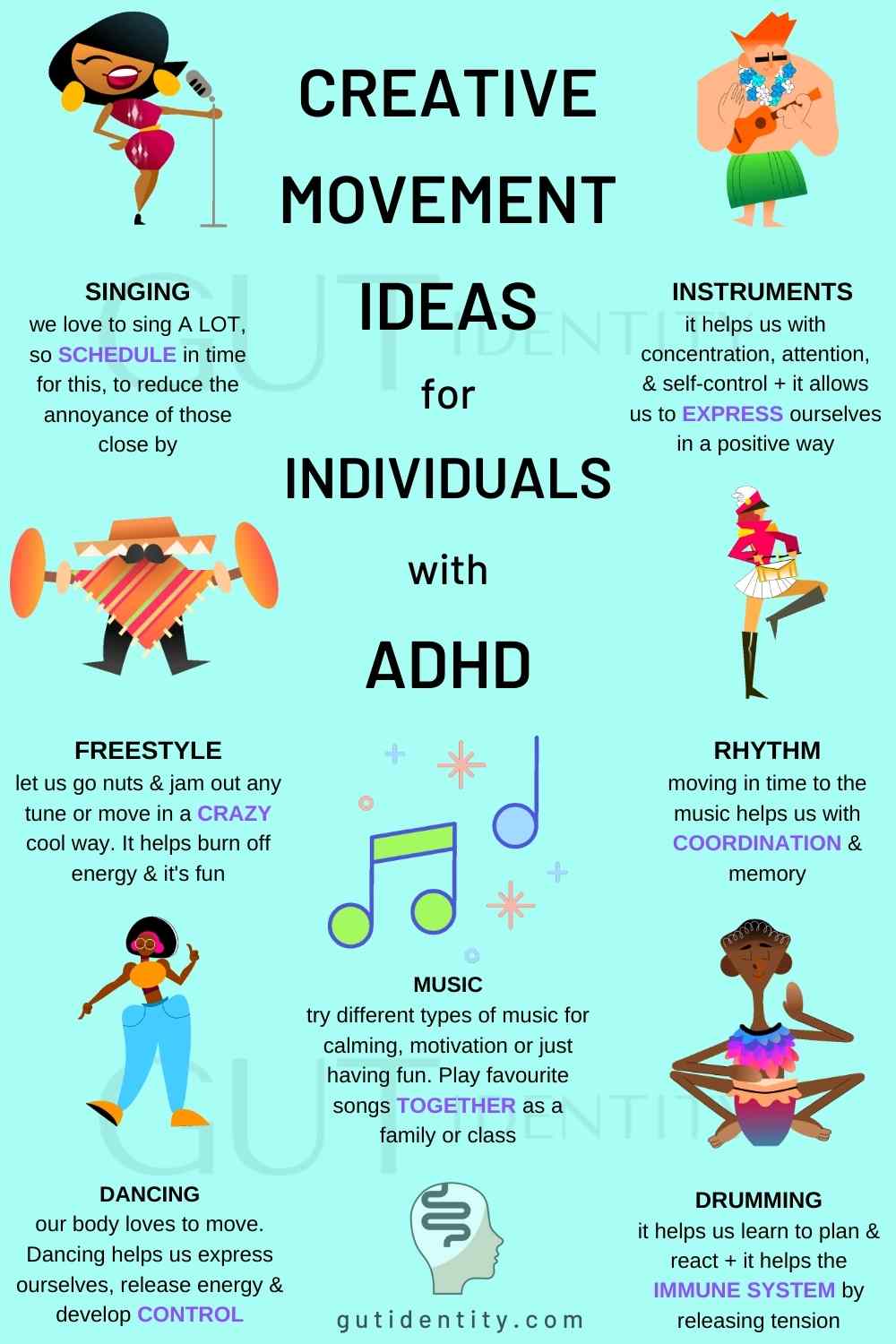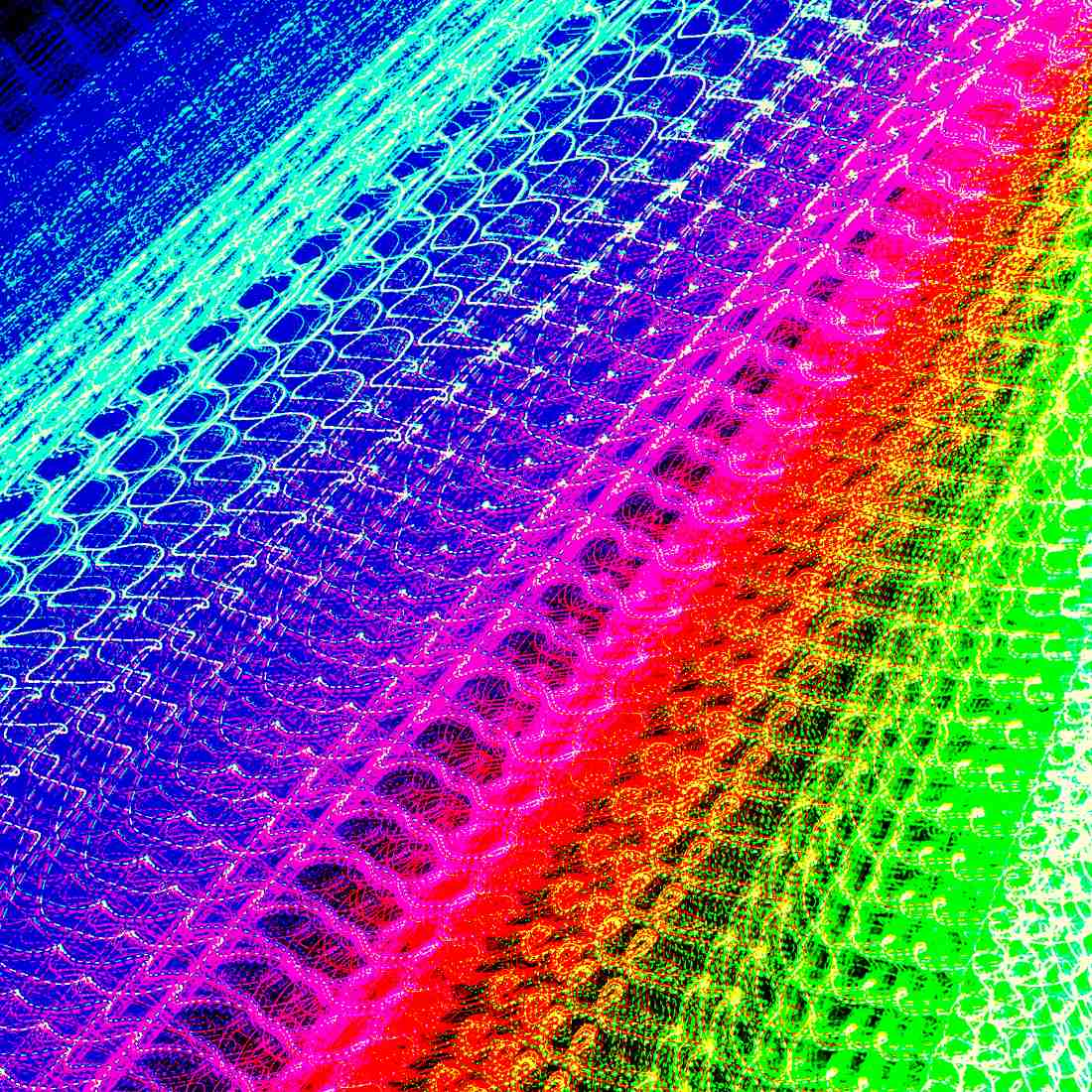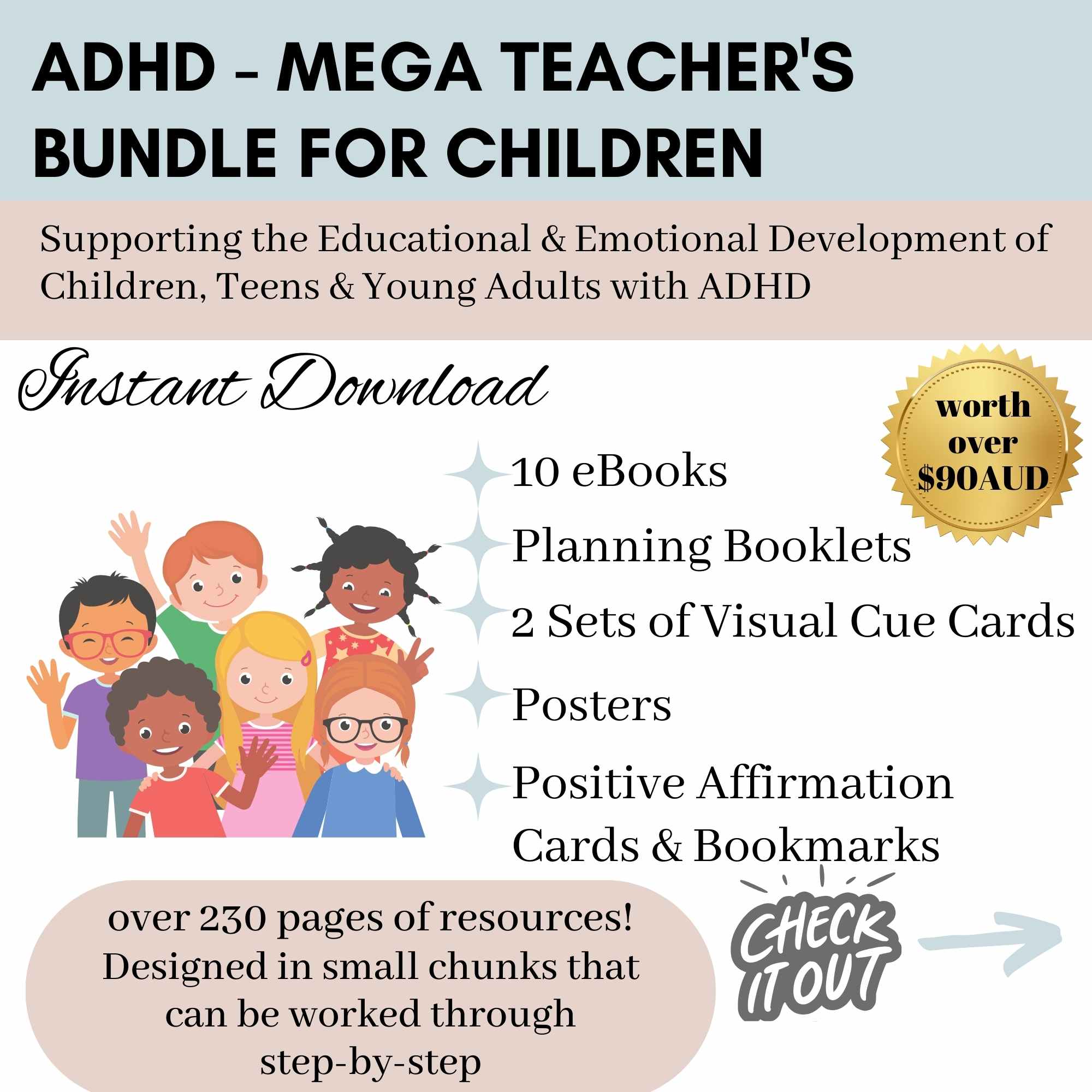Children with ADHD love movement and there are many creative ideas that can encourage movement in different ways.
The infographic below outlines the different ways, children with ADHD can be encouraged to express their creativity through movement.

Playing an Instrument
Playing any type of instrument helps with coordination, attention, and concentration. It also helps develop self-control because focus and attention needs to be placed on timing, listening and then responding. Instrumental play also helps with the coordination between the senses of hearing, sight and touch.

Playing an instrument doesn’t have to be expensive or complicated. Playing a shaker or triangle can help a child join in in their own unique way. This is good in group sessions where a child can join in with a group, without the need to be overly coordinated.
Music, Rhythm and ADHD
Music and moving to the rhythm not only helps coordination and memory, it just feels good. It also allows for the release of energy in positive ways. As a child, I would swing for long periods of time listening to a small radio that my grandma gave me. The combination of moving and music was not only fun, it promoted feelings of calm.
As a teacher, I used music with my students in different ways throughout my teaching career. I had a warmup playlist set up, of music that was 80 beats per minute. We did thigh-slapping, clapping, finger-clicking and side-stepping to different songs. This provided a great opportunity to teach hand-eye coordination and attention. It was a great way to get them focused, relaxed and settled after a break.

Using music this way, helped my students forget what had (or hadn’t) happened over break time, allowing us all to relax into the session in a more positive way. And I have to admit, it was one of my most favourite sessions of the day because it did the same for me, despite me being super uncoordinated.
Drumming
Drumming might not be the go if you want a quiet home. I’ve given it a go myself (not seriously), but I’ve worked with many students with ADHD who have been awesome on the drums. When working in Special Education Schools, we did a lot of drumming in small groups where students, who had multiple and complex disabilities, could participate, have fun and let go.

Beating down on a drum of any kind is a great way to release tension. Built-up tension in our bodies can create feelings of stress, and ongoing stress can lead to inflammation in the body. It’s now thought that inflammation can affect the proper functioning of our immune system.
Think about how many times you are tapping with either a leg or a foot, a hand or even a pen, during the day. How does it feel? It’s hard to NOT move when music comes on. It’s almost a natural instinct to start DRUMMING and moving.
Beating a drum of any kind could help relieve any long-term stress and tension in our body, so it’s worth and short term noise. There is growing evidence on the positive effects it brings, so wouldn’t it be worth trying? Give it a go.
Get Creative with Music Playlists
Music has the incredible ability to change how we feel. Different genres of music can either bring us up, calm us, or make us incredibly emotional. It can change our emotions instantaneously while giving us the motivation to get stuff done. For us adults, music can help get us in the mood for cooking, cleaning and other stuff that we don’t find interesting.
Read more about ‘ADHD and Music’.
Using Music & Movement with Groups
Music also works wonders for children when we want them to start packing up or doing stuff in general. A song can act as a timer of sorts and is a brilliant way to get kids moving when it’s time to pack up.
This strategy can be done at home or at school. I’ve used it in this way in private homes working with families and in school settings. The children would have 1 song to pack up before transitioning to the next activity.
Making a playlist for certain activities, groups, and individuals, means that the songs we might need in a hurry, are at our fingertips when needed. Calming music is a great way to settle children after a break or when there’s much needed ‘quiet’ time first thing in the morning or afternoon.
Movement through Dance
Our bodies were designed to move but over the years we have become more sedentary. A lot of work (and leisure) time is done either sitting on a chair or on the floor. When we get home, we often do the same thing unless we make a conscious effort to be active.

As we age, we seem to do more sitting unless we actually schedule it in and make it part of our routine. Dancing, doesn’t have to mean forking out cash for expensive dance lessons or even leaving the home. It can be as simple as playing a few songs and dancing around the house with, or without children.
Try putting on music next time you do the dishes and watch to see if it makes doing those dishes just that bit more bearable when dancing. Just try not to smash the plates or glasses!
Freestyle
Some of my most memorable times as a teacher, was letting kids go nuts to music. I wouldn’t do this before reading or a test for obvious reasons, but it’s certainly appropriate at other times of the day. Freestyle is a great way for children (and us adults) to express ourselves without having to be the most coordinated folk in the room. If you could see me Zumba, you’d know why.
Chuck on some top chooons and let the kids go for it….. and try it yourself. You may just enjoy it.
ADHD, Singing & Look OUT!

Anyone who has worked with a student with ADHD, or lives with an individual with ADHD, will get this. The impulsive nature of ADHD doesn’t just come in the form of talking a lot. It comes out in the form of singing a lot of the time.
Sometimes songs are constantly on repeat and this often translates to actual singing. It can be irritating to those around us so scheduling this in, or buying some noise-cancelling headphones might be on the cards. Or better still, take time each day to just sing.
Singing relieves stress, encourages expression, and it’s in every culture around the world. Singing and music unite people. It brings people together, can be super relaxing and enjoyable for everyone. It doesn’t have to be ‘Kumbaya’, it can be anything. Get CREATIVE!
Just have FUN and MOVE!

ADHD Resources for Children
Further Reading & Info
ADHD and Difficulty with Moving to the Beat of Music
Music Games and Rhythmic Training






I like how you talk about how drumming can relieve stress. My partner’s nephew has ADHD and he has a lot of trouble focusing which can get him really upset. His mom has been thinking about taking him to drum lessons to help improve his focus and understanding of time.
Yeah, drumming can really help us to feel calm. Anything that involves rhythm, especially around 80bpm can be beneficial. When I’ve worked in special education settings, drumming was always something that the students really enjoyed for different reasons.